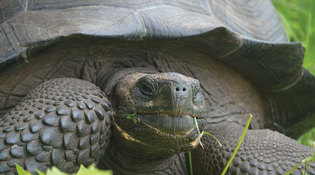 loading
loading
FindingsA new giant tortoiseYale researchers find a new species in the Galápagos.  Washington TapiaView full imageCharles Darwin would be pleased: a Yale-led group has discovered a new species of the Galápagos tortoises that helped shape his theory of evolution. After a study of the DNA, Chelonoides donfaustoi—named after a beloved Galápagos ranger, Fausto Llerena Sánchez—is generally considered to be the 11th living species of the reptile genus. (Four are thought to be extinct.) C. donfaustoi owes its discovery in part to the Association for Yale Alumni (AYA), says Adalgisa Caccone ’86PhD, who directs Yale’s Molecular Systematics and Conservation Genetics Center. She led the team, but it was her husband, Yale biologist Jeff Powell, who started the project—after he went with an AYA group to the Galapágos. Acting on the hunch of a US Geological Survey biologist, Caccone’s research team has found that Santa Cruz Island, in the center of the Galapágos chain, actually supports two kinds of tortoise rather than one. The new species has only 250 individuals. “About two-thirds of C. donfaustoi’s range is in the national park, but an increasing human population in the area outside the park has put the rest of the range under pressure from farming and tourism,” says Caccone.
The comment period has expired.
|
|